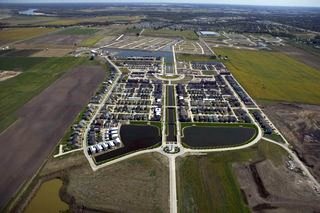New Urban News: “Containing development at the fringe” is the way to reduce CO2

Posted June 25, 2009 at 1:33PM
In the June 2009 issue of New Urban News, researchers Lawrence Frank and Sarah Kavage report that "location [of a neighborhood] within a region" is a highly significant determinant of residents' travel behavior and, therefore, "containing development at the fringe of the urban area" is "quite effective" in reducing CO2 emissions. Other significant factors include land-use mix, street connectivity, and the presence and quality of transit service.
 Frank is a well-known scholar who holds a chair in sustainable transportation at the University of British Columbia. He founded and led the seminal SMARTRAQ study on travel behavior in Atlanta a decade ago when he was at Georgia Tech.
Frank is a well-known scholar who holds a chair in sustainable transportation at the University of British Columbia. He founded and led the seminal SMARTRAQ study on travel behavior in Atlanta a decade ago when he was at Georgia Tech.
The key takeaway from the current article: where development goes matters, not just how it is designed. Incidentally, Frank and Kavage found that a neighborhood's residential density is generally not a significant factor once it is isolated from the other key determinants of travel patterns.
Now, while my friends Reid Ewing and Eliot Allen (no slouches themselves in the study of travel behavior) have been telling me the importance of location and regional accessibility for a decade, I think it is both significant and encouraging that the new article appears in the monthly bible of new urbanism. (Unfortunately, the article - "Which factors matter, and why" - is not available online.) Most new urbanists I know are architects who do not choose the location of their projects. As a result, they are far more concerned with (and more skilled at) doing a good job wherever their client wants to build than they are with curtailing suburban expansion beyond the current fringe. "Since development beyond the fringe is inevitable, let's just make it better" has been the guiding principle. Could change be in the air?
James Howard Kunstler, author of many books including The Geography of Nowhere, and longtime chronicler of the urban/suburban condition, seems to think so. After returning from the annual meeting earlier this month of the Congress for the New Urbanism in Denver, Kunstler had this to say:
"[New urbanists] have had to shift their focus starkly. For years, their stock-in-trade was the greenfield New Town or Traditional Neighborhood Development (TND), a severe reform of conventional suburban development. That sort of reform work was only possible when 1.) the continued expansion of suburbia seemed utterly inevitable, requiring heroic mitigation and 2.) when they could team up with the production home-builders to get their TND projects built. To the group's credit, they realize that these conditions are no more. Suburbia is now cratering, both as a repository of wealth in real estate and as a practical matter of everyday existence."
Now, Kunstler is not a man given to nuance, and I frequently disagree with some of his points, if not usually his general thrust. But I absolutely agree that conditions have changed and that ever-expanding suburbia no longer need be accepted as an inevitable land-use paradigm. I hope that he is right in the rest of his paragraph, too.